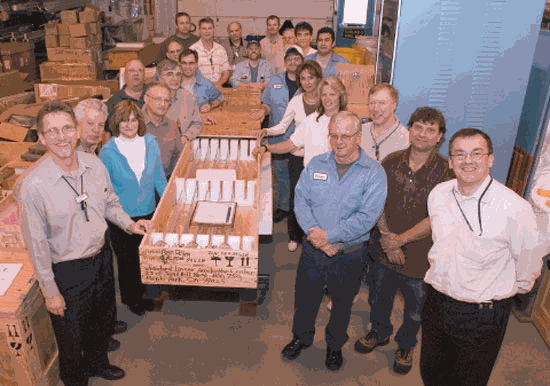The final five (of 40) extruded aluminum vacuum chambers for the Linac Coherent Light Source (LCLS) undulator system have been shipped from Argonne National Laboratory — where the chambers were designed and assembled — to the Stanford Linear Accelerator Center, where the LCLS “will be the world's first x-ray free electron laser when it becomes operational in 2009. Pulses of x-ray laser light from LCLS will be many orders of magnitude brighter and several orders of magnitude shorter than what can be produced by any other x-ray source available now or in the near future.”
The famous final five chambers, crated in Argonne building 382 and ready for shipment to SLAC, are surrounded by (left to right) Pat Den Hartog (AES-MED), Emil Trakhtenberg (AES-MED), Loretta Cokeley (AES-MED), Efim Gluskin (Director, Accelerator Systems Division), Keith Knight (AES-SA), Bill Ruzicka (Director, AES), Russ Otto (AES-MED), Kevin Knoerzer (AES-MED), Mark Martens (AES-MOM), Mark Erdmann (AES-MED), Joe Gagliano (AES-MOM), Tom Barz (AES-ADM), Wayne Michalek (AES-MOM), Horst Friedsam (AES-SA), Soon Hong Lee (AES-MED), Paul Aguirre (AES-MOM), Aaron Lopez (AES-MOM), Daniela Capatina (AES-MED), Kris Mietsner (AES-SA), Greg Wiemerslage (AES-MED), Dan Nocher (AES-MED), Mike Bosek (AES-MED), and Murray Gibson (Associate Laboratory Director, Scientific User Facilities; Director, Advanced Photon Source).
According to Pat Den Hartog, leader of the Mechanical Engineering and Design (MED) Group in the APS Engineering Support Division (AES), producing the chambers was technologically challenging. The MED Group, which spearheaded the design and production effort, had to develop a special process for creating a mirror-like surface through the entire interior length of each 3.4-m-long chamber, inside a very small aperture of 5 mm. “We ended up adapting a commercial process, called ‘abrasive flow machining,’ that uses a paste with an abrasive in it that is pushed through the chamber by a ram,” said Den Hartog. “Normally this process is used over very short lengths employing an oscillating process. We needed a technique applicable to relatively long lengths. We first did a great deal of testing to determine the correct type of abrasive and abrasive flow, and then we developed a once-through technique, together with very careful temperature monitoring to control the viscosity of the abrasive.
“The other technical challenge was in machining the chambers so that they are extremely flat and accurate to allow for alignment at very rigid tolerances when the chambers are installed at the LCLS. The tolerance within the gap of the undulator is plus or minus just 25 microns over the entire length of the LCLS undulator. Each chamber was aligned to that tolerance here at Argonne before shipment.”
The MED Group worked closely with industry on the project. One vendor fabricated the extrusions to much-better-than-standard tolerances, while another polished them to APS specifications. The extrusions were shipped to a third vendor for machining before being returned to the APS where vacuum flanges were welded on and the chambers were cleaned and vacuum-tested to 10-9 Torr. After a rigorous quality assurance process, the completed chambers were shipped to SLAC for installation.
Emil Trakhtenberg of MED, project chief engineer, conceived the polishing technique, while Greg Wiemerslage (MED) was instrumental in developing the process while working with the vendors, and Mark Erdmann (MED) handled the quality assurance process. Many other engineers and technicians from APS and from around Argonne contributed to the success of the project.
Next up for the APS vacuum engineers and technicians: producing the vacuum chambers for the 792-m-circumference NSLS II storage ring at Brookhaven National Laboratory. The LCLS and NSLS II vacuum chambers are just the latest in a long list of projects that evolved from the success of the vacuum chambers developed during construction of the APS. Other light sources using APS-designed and produced chambers include the Canadian Light Source, the Swiss Light Source, the European Synchrotron Radiation Facility, the BESSY synchrotron, and the DESY free-electron laser project.

